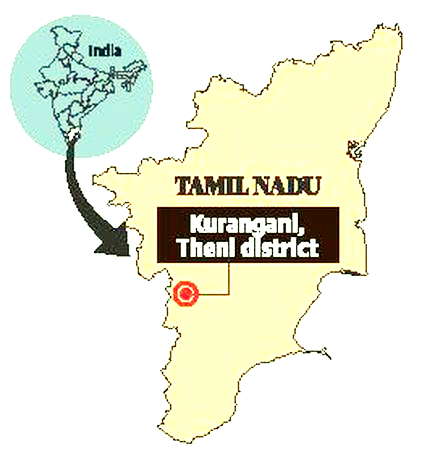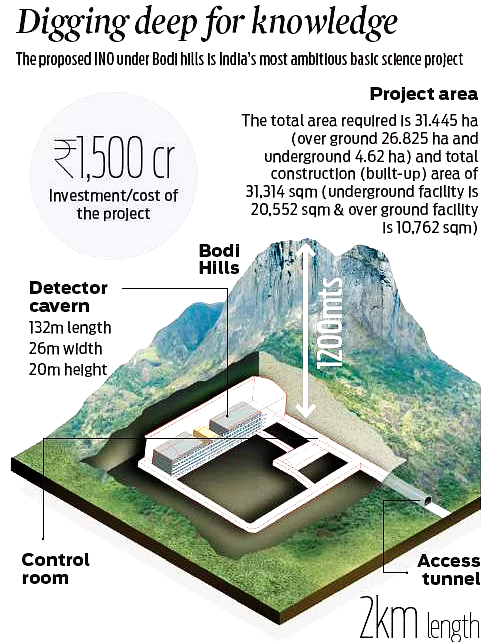Science & Technology
Indian Neutrino Observatory
- 21 Feb 2022
- 8 min read
For Prelims: Indian Neutrino Observatory (INO), Neutrinos, Western Ghats, sensitive ecological zone, Periyar Tiger Reserve, Shola National Park, global biodiversity hotspot, supernovae
For Mains: Achievements of Indians in Science & Technology, Scientific Innovations & Discoveries, Indian Neutrino Observatory (INO),Neutrinos, arguments against INO, Future Applications of Neutrinos
Why in News
Recently, the Tamil Nadu Government has made clear to the Supreme Court that it does not want the Indian Neutrino Observatory (INO) to be set up in Eco-Sensitive Zones in the Western Ghats.
- INO will incur great cost to wildlife, biodiversity and ignores the local opposition.
- Eco-Sensitive Zones are areas within 10 kms around Protected Areas, National Parks and Wildlife Sanctuaries.
What are the arguments of the Tamil Nadu Government?
- The Government asserted that the project falls exactly on the hill slopes of this part of the Western Ghats, which align within it a significant tiger corridor, namely the Mathikettan-Periyar tiger corridor.
- This corridor links the Periyar Tiger Reserve along the Kerala and Tamil Nadu borders and the Mathikettan Shola National Park.
- Quarrying and construction activities will upset wild animals which use the corridor for seasonal migrations.
- The area is a significant watershed and catchment zone for the rivers Sambhal and Kottakudi.
- Though the experiments in the observatory would be conducted a kilometre underground, massive blasting, activities like transportation, excavations and tunnelling among others, would jeopardise the ecological sustainability of the zone, deep in the Western Ghats.
- The protection of the Western Ghats was supreme as they are a global biodiversity hotspot and a treasure trove of biological diversity.
What is the Indian Neutrino Observatory (INO)?
- It is a proposed particle physics research mega project.
- The objective of the project was to study neutrinos in a 1,200-metre deep cave.
- The project is proposed to be set up at Pottipuram village in Theni district in Tamil Nadu.
- The project was initially mooted by the Institute of Mathematical Sciences and then by the Tata Institute of Fundamental Research.
What is the Importance of Proposed Site Location?
- The proposed site in Theni district was identified because the rock burden of over 1 km in all directions shields the detector from other cosmic rays.
- Since neutrinos can easily pass through anything, they will reach the detector while the other particles will be filtered out by the rock in the mountain.
- The geographical location is also peculiar as all the existing neutrino detectors (in other countries) are at latitudes larger than 35 degrees North or South.
- There is none close to the equator as yet.
What are Neutrinos?
- A neutrino is a fundamental elementary particle, and atmospheric neutrinos can be studied when solar radiation hits the earth’s atmosphere.
- They are very hard to detect as they hardly interact with other forms of matter due to their lack of electrical charge.
- However, they seem to play an important role in the universe of elementary physics, which physicists have been trying to understand for a few decades now.
- They are produced in high-energy processes such as within stars and in supernovae.
- On earth, they are produced by particle accelerators and nuclear power plants.
- They are produced in high-energy processes such as within stars and in supernovae. On earth, they are produced by particle accelerators and nuclear power plants.
- So far, neutrino physics has been mostly limited to outer space sources, observing neutrinos from farther-away stars and galaxies.
What can be the Future Applications of Neutrinos?
- Properties of the Sun: The visible light is emitted from the surface of the sun and neutrinos, which travel close to the speed of light, are produced in the core of the sun.
- Studying these neutrinos can help us understand what goes on in the interior of the sun.
- Constituents of the Universe: Light coming from distant stars can be studied by astronomers, for example, to detect new planets.
- Likewise, if the properties of neutrinos are understood better, they can be used in astronomy to discover what the universe is made up of.
- Probing Early Universe: Neutrinos interact very little with the matter around them, so they travel long distances uninterrupted. The extragalactic (originating outside the Milky Way galaxy) neutrinos we observe may be coming from the distant past.
- These undamaged messengers can give us a clue about the origin of the universe and the early stages of the infant universe, soon after the Big Bang.
- Medical Imaging: Apart from direct future uses of neutrinos, there are technological applications of the detectors that will be used to study them.
- For instance, X-ray machines, MRI scans, etc., all came out of research into particle detectors.
- Hence the INO detectors may have applications in medical imaging.
What are Eco- Sensitive Zones?
- Eco-Sensitive Zones or Ecologically Fragile Areas are areas within 10 kms around Protected Areas, National Parks and Wildlife Sanctuaries.
- In case of places with sensitive corridors, connectivity and ecologically important patches, crucial for landscape linkage, even areas beyond 10 km width can be included in the eco-sensitive zone.
- ESZs are notified by the Ministry of Environment, Forest, and Climate Change (MoEFCC), under Environment Protection Act, 1986.
- The basic aim is to regulate certain activities around National Parks and Wildlife Sanctuaries so as to minimise the negative impacts of such activities on the fragile ecosystem encompassing the protected areas.






